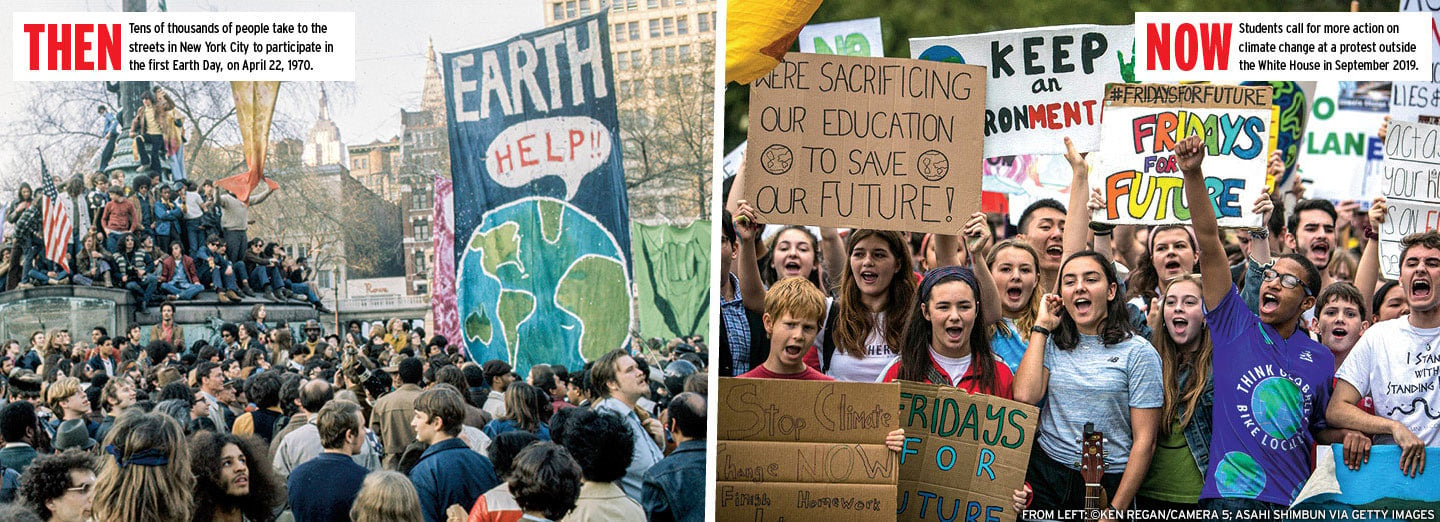At noon on April 22, 1970, all cars, taxis, and buses were barred from a two-mile stretch of Fifth Avenue in New York City. A massive crowd of 250,000 people packed the streets to celebrate the first-ever Earth Day.
Denis Hayes had dropped out of Harvard graduate school, where he’d been studying public policy, to organize the events. As he stood on a platform on Fifth Avenue, preparing to give a speech, the 25-year-old couldn’t believe his eyes.
“It was like looking at the ocean,” Hayes, now 75, says. “You couldn’t see the edge of the crowd. And that’s when I first thought, ‘My god, this really is gigantic.’”
At the same time, all across the country, thousands of demonstrations were taking place—many of them led by teenagers. In Omaha, Nebraska, high school students wore gas masks to protest air pollution; in Ripon, Wisconsin, young people collected 25,000 discarded cans; and thousands of colleges and schools hosted environment-themed events. In total, an estimated 20 million people took part in Earth Day—more than the largest civil rights and anti-Vietnam War protests of the 1960s.
This year, on April 22, people worldwide are expected to participate in the 50th Earth Day. Because of the coronavirus pandemic, it will be the first digital Earth Day, with events including virtual protests, social media campaigns, and online teach-ins.
It comes as young people are once again on the front-lines of environmental demonstrations—this time, calling for more action on climate change. But it was that first Earth Day 50 years ago that helped spark the modern environmental movement, paving the way for today’s activists.
“No one even used the phrase ‘environmental movement’ until the very end of 1969, beginning of 1970, and it was only in stories about the preparation for what became Earth Day,” says environmental historian Adam Rome, author of The Genius of Earth Day. “There were obviously a lot of concerns for environmental problems, but nobody understood that they all added up to one big environmental crisis until the lead-up to Earth Day and Earth Day itself.”
At noon on April 22, 1970, all cars, taxis, and buses were barred from a two-mile stretch of Fifth Avenue in New York City. A massive crowd of 250,000 people packed the streets to celebrate the first-ever Earth Day.
Denis Hayes had been studying public policy at Harvard graduate school. He dropped out to organize the events. As he stood on a platform on Fifth Avenue, preparing to give a speech, the 25-year-old couldn’t believe his eyes.
“It was like looking at the ocean,” Hayes, now 75, says. “You couldn’t see the edge of the crowd. And that’s when I first thought, ‘My god, this really is gigantic.’”
At the same time, thousands of demonstrations were taking place all across the country. Many of them were led by teenagers. In Omaha, Nebraska, high school students wore gas masks to protest air pollution. In Ripon, Wisconsin, young people collected 25,000 discarded cans. And thousands of colleges and schools hosted environment-themed events. In total, an estimated 20 million people took part in Earth Day. The event drew more people than the largest civil rights and anti-Vietnam War protests of the 1960s.
This year, on April 22, people worldwide are expected to participate in the 50th Earth Day. Because of the coronavirus pandemic, it will be the first digital Earth Day. Events will include virtual protests, social media campaigns, and online teach-ins.
It comes as young people are once again on the front lines of environmental demonstrations. This time, they’re calling for more action on climate change. But it was that first Earth Day 50 years ago that helped spark the modern environmental movement. Those who took part paved the way for today’s activists.
“No one even used the phrase ‘environmental movement’ until the very end of 1969, beginning of 1970, and it was only in stories about the preparation for what became Earth Day,” says environmental historian Adam Rome, author of The Genius of Earth Day. “There were obviously a lot of concerns for environmental problems, but nobody understood that they all added up to one big environmental crisis until the lead-up to Earth Day and Earth Day itself.”

